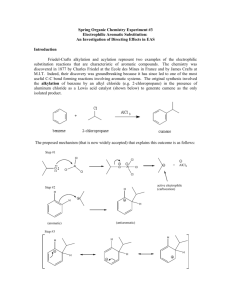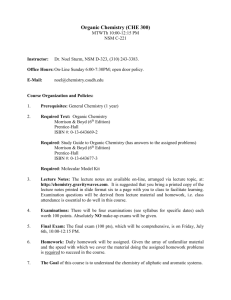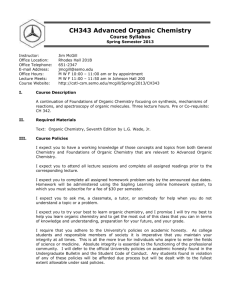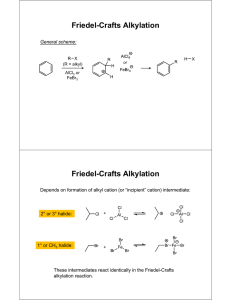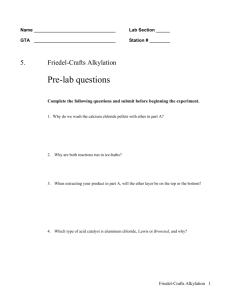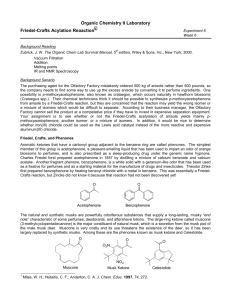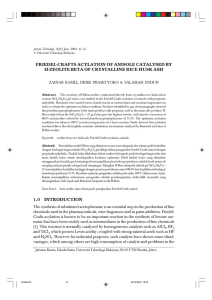The Friedel-Crafts Acylation - Chemistry at Winthrop University
advertisement
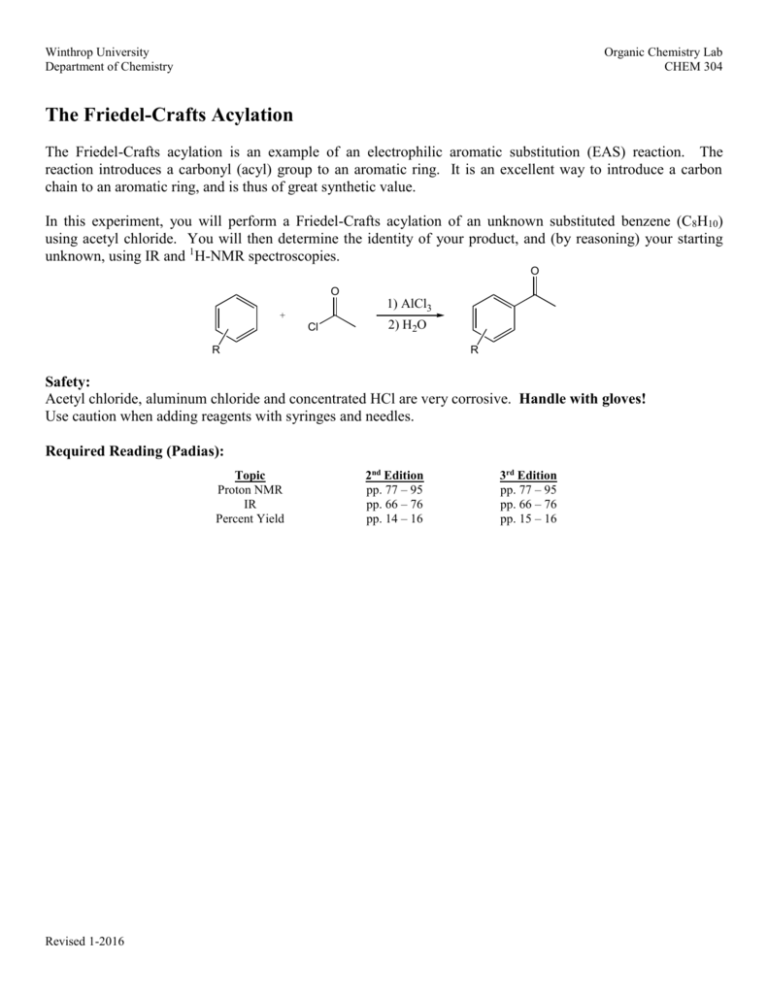
Winthrop University Department of Chemistry Organic Chemistry Lab CHEM 304 The Friedel-Crafts Acylation The Friedel-Crafts acylation is an example of an electrophilic aromatic substitution (EAS) reaction. The reaction introduces a carbonyl (acyl) group to an aromatic ring. It is an excellent way to introduce a carbon chain to an aromatic ring, and is thus of great synthetic value. In this experiment, you will perform a Friedel-Crafts acylation of an unknown substituted benzene (C8H10) using acetyl chloride. You will then determine the identity of your product, and (by reasoning) your starting unknown, using IR and 1H-NMR spectroscopies. O O + Cl 1) AlCl3 2) H2O R R Safety: Acetyl chloride, aluminum chloride and concentrated HCl are very corrosive. Handle with gloves! Use caution when adding reagents with syringes and needles. Required Reading (Padias): Topic Proton NMR IR Percent Yield Revised 1-2016 2nd Edition pp. 77 – 95 pp. 66 – 76 pp. 14 – 16 3rd Edition pp. 77 – 95 pp. 66 – 76 pp. 15 – 16 Winthrop University Department of Chemistry Organic Chemistry Lab CHEM 304 Procedure: Place 800 mg of AlCl3 into a 10 mL round bottom flask with a spin vane. Add 2 mL of dichloromethane and add a Claisen adapter, rubber septum and drying tube as shown below. Place the assembly under the hood and add 0.5 mL of acetyl chloride dropwise via syringe with stirring. In a 3 mL conical vial, weigh out 425 mg of your unknown. Add the unknown to your reaction flask dropwise via syringe, and stir for 30 minutes. Slowly add 4 mL of ice water dropwise via syringe and remove the septum. Add 4 mL of concentrated HCl using a pipet, and stir until the solids dissolve. Transfer the mixture to a separatory funnel, rinsing the flask with 1 mL of dichloromethane. Drain the lower organic layer into a small Erlenmeyer flask and remove the aqueous layer. Return the organic layer to the separatory funnel and wash with 1 mL of 5% sodium bicarbonate (vent frequently!). Drain the organic layer into a 5 mL conical vial, and dry the solution over Na2SO4. Transfer the solution to a small pre-weighed beaker and evaporate the solvent by warming gently under the hood. Determine the weight of your product, and obtain IR and 1H-NMR spectra. Lab Report Guidance Be sure to review the “Report Guidelines” and “Example Reaction Lab Report” documents on the course webpage. You should now have a good idea of how to prepare each of the required sections of a CHEM 304 lab report. Refer to your previous experiments for guidance. Make sure you thoroughly interpret your IR and 1H-NMR spectra. Use these spectra to determine the structure of your product. Discuss how the NMR signal frequencies, integrations, and multiplicities are consistent with your proposed product. Determine the identity of your starting material from the structure of your product and your knowledge of EAS chemistry. Calculate the percent yield (show the calculation) of your product. Revised 1-2016 Winthrop University Department of Chemistry Organic Chemistry Lab CHEM 304 Questions (Fully explain how you arrived at each answer, including all calculations.) 1. The Friedel-Crafts acylation of benzene gives only the monosubstituted product, even when an excess of catalyst and acyl chloride are used. Explain why. 2. The Friedel-Crafts acylation of benzene with phosgene and aluminum chloride gives a product with the formula C13H10O. What is the structure of the product? Explain how this product is formed. 3. Using Spartan, o-nitrotoluene: model the Highest Occupied Molecular Orbital (HOMO) of a) Construct a model of o-nitrotoluene (to attach a nitro group, select “nitro” from the “Groups” dropdown box). Minimize the energy by clicking on the button. b) Select “Setup” “Calculation.” In the “calculate” box, choose “Equilibrium Geometry” at the “Ground” state with “Semi-Empirical” “AM1” model. Click “OK.” Do not submit the calculation at this time. c) Select “Setup” “Surfaces.” Click “Add” and from the “Surface” dropdown box select “HOMO.” Check the “Fixed” box next to “Isovalue” and enter 0.11 in the field, click “OK”. Leave the surfaces dialog box open. d) Select “Setup” “Submit” to submit the calculation. Click “Save” when the “Save as” dialog box appears. e) When the calculation is completed, check the box next to “homo” in the surfaces dialog box. The orbital lobes of the HOMO for o-nitrotoluene will be superimposed on the molecule. Knowing that an electrophile will prefer to attack the atom where the HOMO has its largest lobe, where is the most likely site of attack? Is this consistent with what you know about substituent directing effects in EAS? Be sure to include a printout of the model (showing the HOMO) in your report. Revised 1-2016

